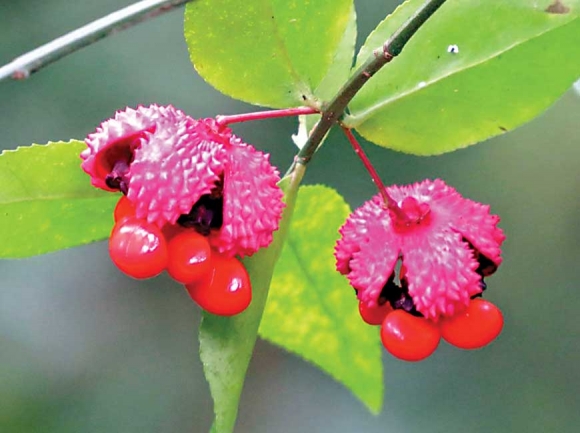The Naturalist's Corner: Hearts are a-bursting
 Hearts-a-burstin with love… Don Hendershot photo
Hearts-a-burstin with love… Don Hendershot photo
I started out the front door, in the early morning light the other day, to check on the whereabouts of our newest family member Remi, a young part Shar-Pei mix we adopted from the shelter last May. Remi has recently decided when she goes out in the morning part of her doggy-duty is to go down the road to our neighbor’s house and bark, and we’ve been trying to convince her that’s really not necessary. While I was focused on Remi, trying to make sure I caught up with her before she had time to make her morning announcements I couldn’t help but notice the incandescent red glow coming from the dappled woods.
It grabbed me in a really familiar place — like when you’re going to meet an old friend you haven’t seen in a while and your thoughts and/or musing are wandering around in a kinda subconscious daydream and then you see your friend’s smile and you’re snatched back to the present and reveling in warm familiar feelings.
And the old friend I saw smiling from the dappled forest sunlight the other morning was Euonymus americanus, hearts-a-busting out with love. This sparse slender shrub is also known as strawberry bush, American strawberry bush, bursting-heart and hearts-a-bustin. The common names all have to do with the shrub’s fruit. The fruit is contained in a rough globular capsule that begins to turn pinkish in late summer, superficially resembling a strawberry. Then as the fruit matures it “bursts” open to reveal five small, shiny, intensely red berries.
After Remi and I returned (bark-less!), I grabbed my camera and took a few shots of those glowing berries. I posted the photos on my Facebook page, which prompted this response from Bob Gale, ecologist and public lands director at Mountain True, “This plant is almost unnoticeable and completely uninteresting to most people (except us botany nerds) for most of the year. This is when it comes into its glory!”
And while it does fly under the radar most of the year, when it’s a bursting it’s quite dazzling. In fact, this showy display prompted early European botanists to export the shrub back to Europe for horticultural use as early as 1663.
Euonymus americanus is a deciduous shrub that grows across the eastern U.S. from central Florida to Texas and north to the Great Lakes. It is typically an understory species and reaches a height of about six feet. The narrow opposite leaves grow along bright green stems and it produces small flat pale green flowers in late spring. It is a preferred forage of white-tailed deer and in places with high densities of deer it is browsed heavily greatly reducing any kind of late summer hearts-a-bursting displays. Birds also eat the berries but all parts of the plant are toxic to domestic cattle and sheep. It is toxic to humans too but only in large quantities. The deciduous leaves turn whitish/yellowish, often suffused with pink before falling in the fall.
Related Items
Hearts-a-bursting, because of its dazzling fruit and unique fall foliage, is finding its way into more lawns and gardens. And thankfully this unobtrusive beauty is not invasive like it’s Asian cousin, burning bush Euonymus alatus.
I will enjoy my botanical friend now till it’s bereft of leaves and dozes for the winter. Then next September, like this September and Septembers past I will once again be surprised when I “suddenly” discover my old friend in all its glory.
(Don Hendershot is a naturalist and a writer who lives in Haywood County. He can be reached at This email address is being protected from spambots. You need JavaScript enabled to view it.)









